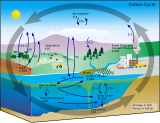
A: Mesophyll cell
B: Chloroplast
C: Vascular tissue
D: Bundle sheath cell
E: Stoma
F: Vascular tissue
1. CO2 is fixed to produce a four-carbon molecule (malate or aspartate).
2. The molecule exits the cell and enters the bundle sheath cells.
3. It is then broken down into CO2 and pyruvate. CO2 enters the Calvin cycle to produce carbohydrates.
4. Pyruvate reenters the mesophyll cell, where it is reused to produce malate or aspartate.
| Part of a series on the |
| Carbon cycle |
|---|
 |
C4 carbon fixation or the Hatch–Slack pathway is one of three known photosynthetic processes of carbon fixation in plants. It owes the names to the 1960s discovery by Marshall Davidson Hatch and Charles Roger Slack.[1]
C4 fixation is an addition to the ancestral and more common C3 carbon fixation. The main carboxylating enzyme in C3 photosynthesis is called RuBisCO, which catalyses two distinct reactions using either CO2 (carboxylation) or oxygen (oxygenation) as a substrate. RuBisCO oxygenation gives rise to phosphoglycolate, which is toxic and requires the expenditure of energy to recycle through photorespiration. C4 photosynthesis reduces photorespiration by concentrating CO2 around RuBisCO.
To enable RuBisCO to work in an environment where there is a lot of carbon dioxide and very little oxygen, C4 leaves generally contain two partially isolated compartments called mesophyll cells and bundle-sheath cells. CO2 is initially fixed in the mesophyll cells in a reaction catalysed by the enzyme PEP carboxylase in which the three-carbon phosphoenolpyruvate (PEP) reacts with CO2 to form the four-carbon oxaloacetic acid (OAA). OAA can then be reduced to malate or transaminated to aspartate. These intermediates diffuse to the bundle sheath cells, where they are decarboxylated, creating a CO2-rich environment around RuBisCO and thereby suppressing photorespiration. The resulting pyruvate (PYR), together with about half of the phosphoglycerate (PGA) produced by RuBisCO, diffuses back to the mesophyll. PGA is then chemically reduced and diffuses back to the bundle sheath to complete the reductive pentose phosphate cycle (RPP). This exchange of metabolites is essential for C4 photosynthesis to work.
Additional biochemical steps require more energy in the form of ATP to regenerate PEP, but concentrating CO2 allows high rates of photosynthesis at higher temperatures. Higher CO2 concentration overcomes the reduction of gas solubility with temperature (Henry's law). The CO2 concentrating mechanism also maintains high gradients of CO2 concentration across the stomatal pores. This means that C4 plants have generally lower stomatal conductance, reduced water losses and have generally higher water-use efficiency.[2] C4 plants are also more efficient in using nitrogen, since PEP carboxylase is cheaper to make than RuBisCO.[3] However, since the C3 pathway does not require extra energy for the regeneration of PEP, it is more efficient in conditions where photorespiration is limited, typically at low temperatures and in the shade.[4]
- ^ Slack CR, Hatch MD (June 1967). "Comparative studies on the activity of carboxylases and other enzymes in relation to the new pathway of photosynthetic carbon dioxide fixation in tropical grasses". The Biochemical Journal. 103 (3): 660–5. doi:10.1042/bj1030660. PMC 1270465. PMID 4292834.
- ^ Osborne CP, Sack L (February 2012). "Evolution of C4 plants: a new hypothesis for an interaction of CO2 and water relations mediated by plant hydraulics". Philosophical Transactions of the Royal Society of London. Series B, Biological Sciences. 367 (1588): 583–600. doi:10.1098/rstb.2011.0261. PMC 3248710. PMID 22232769.
- ^ Sage RF, Pearcy RW (July 1987). "The Nitrogen Use Efficiency of C(3) and C(4) Plants: I. Leaf Nitrogen, Growth, and Biomass Partitioning in Chenopodium album (L.) and Amaranthus retroflexus (L.)". Plant Physiology. 84 (3): 954–8. doi:10.1104/pp.84.3.954. PMC 1056701. PMID 16665550.
- ^ Bellasio C, Farquhar GD (July 2019). "3 rice: gains, losses and metabolite fluxes". The New Phytologist. 223 (1): 150–166. doi:10.1111/nph.15787. hdl:1885/159508. PMID 30859576.